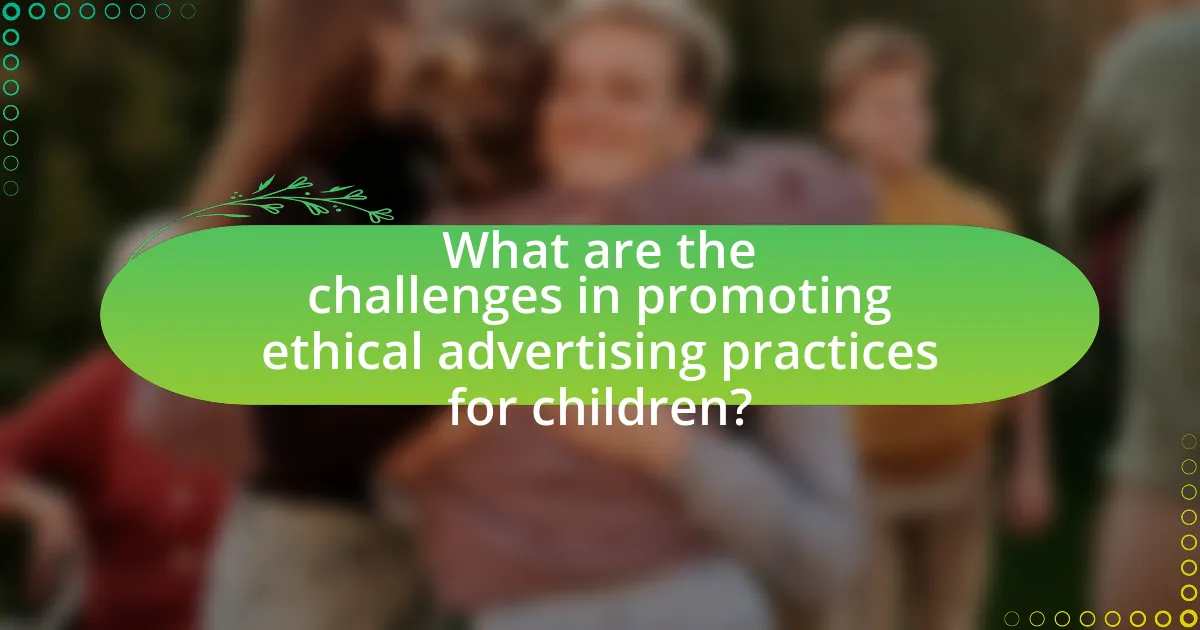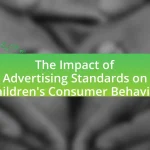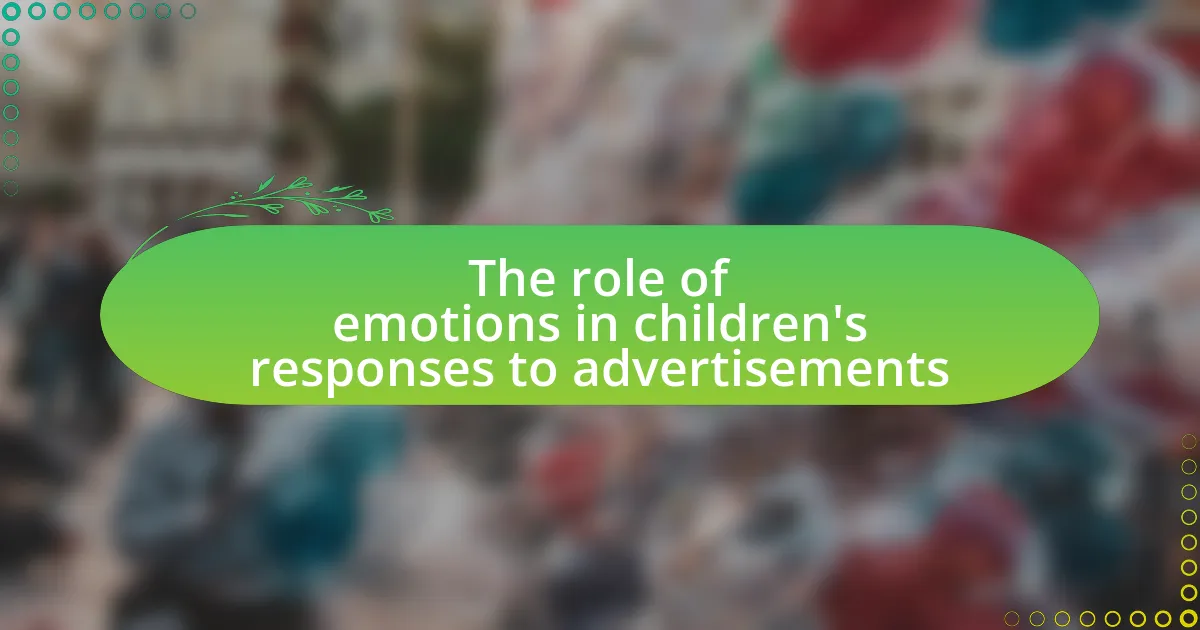The article focuses on strategies for promoting ethical advertising practices for children, emphasizing the importance of truthful, age-appropriate content that respects children’s developmental stages. It outlines the potential harms of unethical advertising, including unhealthy behaviors and materialism, and highlights the benefits of ethical advertising in fostering positive values and critical thinking. Key principles such as honesty, transparency, and adherence to age-appropriate guidelines are discussed, along with the roles of parents, regulatory bodies, and technology in ensuring ethical standards. The article also addresses the challenges advertisers face in maintaining ethical practices amidst competitive pressures and evolving digital landscapes.

What are ethical advertising practices for children?
Ethical advertising practices for children include ensuring that advertisements are truthful, age-appropriate, and do not exploit children’s inexperience or credulity. Advertisers must avoid misleading claims and should present products in a way that is understandable for children, using clear language and visuals. Additionally, ethical practices involve not promoting unhealthy food or harmful products, as supported by guidelines from organizations like the American Psychological Association, which emphasizes the need for responsible marketing to protect children’s well-being.
Why is ethical advertising important for children?
Ethical advertising is important for children because it protects their developmental needs and promotes positive values. Children are impressionable and may not have the cognitive ability to critically evaluate advertising messages, making them vulnerable to manipulation. Research indicates that exposure to unethical advertising can lead to unhealthy behaviors, such as poor dietary choices and materialism. For instance, a study published in the Journal of Advertising Research found that children exposed to misleading food advertisements were more likely to choose unhealthy snacks over healthier options. Therefore, ethical advertising practices help ensure that marketing messages are truthful, age-appropriate, and contribute to the well-being of children.
What are the potential harms of unethical advertising to children?
Unethical advertising to children can lead to significant psychological and behavioral harms. Children may develop unhealthy eating habits due to misleading advertisements promoting junk food, which can contribute to obesity and related health issues; for instance, studies indicate that children exposed to such ads are more likely to choose unhealthy snacks over nutritious options. Additionally, unethical advertising can foster materialism and unrealistic expectations, as children may be influenced to believe that happiness is linked to the acquisition of products, leading to dissatisfaction and anxiety. Research from the American Psychological Association highlights that children under the age of eight often cannot distinguish between advertising and entertainment, making them particularly vulnerable to manipulation.
How does ethical advertising benefit children’s development?
Ethical advertising benefits children’s development by promoting positive values and healthy behaviors. This type of advertising encourages critical thinking and media literacy, helping children discern between genuine messages and manipulative tactics. Research indicates that ethical advertising can foster self-esteem and social responsibility among children, as it often highlights themes of kindness, inclusivity, and environmental awareness. For instance, a study published in the Journal of Advertising Research found that children exposed to ethical advertisements demonstrated improved attitudes towards prosocial behavior, indicating a direct link between ethical messaging and positive developmental outcomes.
What are the key principles of ethical advertising for children?
The key principles of ethical advertising for children include honesty, transparency, and respect for the child’s developmental stage. Ethical advertising must avoid misleading claims and ensure that the content is appropriate for the age group it targets. For instance, advertisements should not exploit children’s inexperience or credulity, as outlined in the American Psychological Association’s guidelines, which emphasize the need for truthful representation of products. Additionally, ethical advertising should promote positive values and not encourage unhealthy behaviors, aligning with the principles set forth by organizations like the World Health Organization, which advocates for responsible marketing practices that protect children’s health and well-being.
How do transparency and honesty play a role in ethical advertising?
Transparency and honesty are fundamental to ethical advertising as they foster trust between advertisers and consumers. When advertisers clearly disclose information about products, including potential risks and benefits, they enable consumers to make informed decisions. For instance, the Federal Trade Commission (FTC) mandates that advertisements must not be misleading and require clear disclosures, particularly in advertising targeted at children, to ensure that young audiences understand the content. This adherence to transparency and honesty not only aligns with ethical standards but also enhances brand reputation and consumer loyalty, as evidenced by studies showing that consumers are more likely to support brands perceived as honest and transparent.
What age-appropriate content guidelines should be followed?
Age-appropriate content guidelines for children should include the following principles: content must be suitable for the child’s developmental stage, avoid violence, explicit language, and adult themes, and promote positive social values. Research indicates that children aged 2-5 benefit from simple, educational content that fosters cognitive and emotional development, while children aged 6-12 can engage with more complex narratives that still adhere to ethical standards. The American Academy of Pediatrics emphasizes that media should be age-appropriate, educational, and promote healthy behaviors, reinforcing the need for content that aligns with these guidelines.

What strategies can be implemented to promote ethical advertising practices for children?
To promote ethical advertising practices for children, implementing strict regulations on content and targeting is essential. Regulatory bodies can enforce guidelines that prohibit misleading claims and ensure that advertisements are age-appropriate, thereby protecting children from exploitation. For instance, the Children’s Online Privacy Protection Act (COPPA) in the United States mandates parental consent for data collection from children under 13, which helps safeguard their privacy and limit targeted advertising. Additionally, educational programs can be developed to teach children critical thinking skills regarding advertising, enabling them to discern between entertainment and marketing. Research indicates that children exposed to media literacy programs demonstrate improved understanding of advertising tactics, leading to more informed consumer behavior.
How can parents and guardians influence ethical advertising?
Parents and guardians can influence ethical advertising by actively engaging in discussions about media literacy and advertising practices with their children. By educating children on how advertisements can manipulate emotions and perceptions, parents help them develop critical thinking skills that enable them to discern ethical from unethical advertising. Research indicates that children who are taught to analyze advertisements are less likely to be swayed by misleading marketing tactics, thereby promoting a culture of ethical advertising. For instance, a study published in the Journal of Advertising Research found that media literacy programs significantly improved children’s ability to recognize persuasive intent in advertisements.
What role do parents play in educating children about advertising?
Parents play a crucial role in educating children about advertising by guiding their understanding of marketing messages and fostering critical thinking skills. They help children discern between persuasive techniques and factual information, enabling them to recognize the intent behind advertisements. Research indicates that children who engage in discussions about advertising with their parents are better equipped to analyze and question the messages they encounter, leading to more informed consumer behavior. For instance, a study published in the Journal of Advertising Research found that parental involvement significantly enhances children’s ability to critically evaluate advertisements, thus promoting ethical consumption practices.
How can parents advocate for ethical advertising standards?
Parents can advocate for ethical advertising standards by actively engaging with policymakers and organizations that regulate advertising practices. By participating in public forums, parents can voice concerns about misleading advertisements aimed at children, thereby influencing legislation that promotes transparency and accountability in advertising. Research indicates that parental involvement in advocacy efforts can lead to significant changes in advertising regulations, as seen in the 2006 Children’s Food and Beverage Advertising Initiative, which was influenced by parental advocacy for healthier advertising practices.
What role do regulatory bodies play in promoting ethical advertising?
Regulatory bodies play a crucial role in promoting ethical advertising by establishing guidelines and standards that ensure advertisements are truthful, not misleading, and appropriate for the target audience. These organizations, such as the Federal Trade Commission (FTC) in the United States, enforce laws that protect consumers, particularly vulnerable populations like children, from deceptive marketing practices. For instance, the Children’s Online Privacy Protection Act (COPPA) mandates that companies obtain parental consent before collecting personal information from children, thereby promoting ethical advertising practices that prioritize children’s safety and privacy.
What regulations currently exist to protect children from unethical advertising?
Regulations that currently exist to protect children from unethical advertising include the Children’s Online Privacy Protection Act (COPPA) in the United States, which restricts the collection of personal information from children under 13 without parental consent. Additionally, the Federal Trade Commission (FTC) enforces guidelines that prohibit deceptive advertising practices targeting children. In the European Union, the Audiovisual Media Services Directive (AVMSD) sets strict rules on advertising to children, including limitations on the types of products that can be marketed and the timing of such advertisements. These regulations aim to safeguard children from misleading and harmful advertising practices, ensuring that their rights and well-being are prioritized in the advertising landscape.
How can regulatory bodies enforce ethical advertising practices?
Regulatory bodies can enforce ethical advertising practices by implementing strict guidelines and monitoring compliance among advertisers. These bodies, such as the Federal Trade Commission in the United States, establish rules that prohibit misleading advertisements and require transparency in marketing, particularly when targeting vulnerable populations like children. For instance, the Children’s Online Privacy Protection Act mandates that websites directed at children must obtain parental consent before collecting personal information, thereby ensuring ethical standards are upheld. Additionally, regulatory bodies can impose penalties for violations, which serves as a deterrent against unethical advertising practices.

What are the challenges in promoting ethical advertising practices for children?
Promoting ethical advertising practices for children faces significant challenges, primarily due to the vulnerability of children to persuasive marketing tactics. Children often lack the cognitive ability to critically evaluate advertisements, making them susceptible to misleading claims and manipulative messaging. Research indicates that children under the age of eight are particularly unable to distinguish between entertainment and advertising, which complicates the enforcement of ethical standards. Additionally, the rapid evolution of digital media platforms creates a constantly shifting landscape that complicates regulatory efforts. For instance, the rise of social media influencers targeting young audiences raises concerns about transparency and the authenticity of endorsements. These factors collectively hinder the implementation of effective ethical advertising practices aimed at protecting children.
What obstacles do advertisers face in adhering to ethical standards?
Advertisers face significant obstacles in adhering to ethical standards, primarily due to the pressure to maximize profits and the competitive nature of the industry. This pressure often leads to the prioritization of persuasive tactics over ethical considerations, resulting in misleading or manipulative advertising practices. For instance, a study by the American Psychological Association highlights that children are particularly vulnerable to such tactics, making it challenging for advertisers to balance profit motives with ethical responsibilities. Additionally, the lack of clear regulatory guidelines can create ambiguity, allowing advertisers to exploit loopholes in ethical advertising practices.
How does competition affect ethical advertising practices?
Competition significantly influences ethical advertising practices by compelling companies to adhere to higher standards to differentiate themselves. In a competitive market, businesses are motivated to build trust and credibility with consumers, which often leads to the adoption of ethical advertising practices. For instance, research indicates that brands that prioritize ethical standards can enhance customer loyalty and brand reputation, as consumers increasingly favor companies that demonstrate social responsibility. A study by the American Marketing Association found that 70% of consumers are more likely to purchase from brands that are perceived as ethical, highlighting the direct correlation between competition and the necessity for ethical advertising.
What are the financial implications of ethical advertising for companies?
Ethical advertising can lead to positive financial implications for companies, including enhanced brand loyalty and increased sales. Companies that engage in ethical advertising often experience a stronger connection with consumers, as 73% of millennials are willing to pay more for products from brands that demonstrate social responsibility. This consumer preference can translate into higher revenues and market share. Additionally, ethical advertising can mitigate risks associated with negative publicity and legal issues, which can be costly; for example, companies that face backlash from unethical practices may incur significant financial losses, as seen in cases like the Volkswagen emissions scandal, which cost the company over $30 billion. Thus, investing in ethical advertising not only fosters consumer trust but also protects companies from potential financial pitfalls.
How can technology be leveraged to promote ethical advertising?
Technology can be leveraged to promote ethical advertising by utilizing data analytics and artificial intelligence to ensure compliance with advertising standards and to target age-appropriate content. For instance, algorithms can analyze user data to filter out advertisements that may not be suitable for children, thereby protecting vulnerable audiences from misleading or harmful messages. Additionally, platforms can implement transparency tools that allow consumers to see how their data is used in advertising, fostering trust and accountability. Research indicates that 70% of parents prefer platforms that provide clear guidelines on advertising content aimed at children, highlighting the demand for ethical practices in digital marketing.
What tools can be used to monitor advertising content aimed at children?
Tools that can be used to monitor advertising content aimed at children include content analysis software, regulatory compliance platforms, and audience measurement tools. Content analysis software, such as MediaSmarts, allows for the evaluation of advertisements to ensure they meet ethical standards and do not exploit children’s vulnerabilities. Regulatory compliance platforms, like AdWatch, help advertisers adhere to legal guidelines regarding children’s advertising. Audience measurement tools, such as Nielsen Kids, provide insights into children’s media consumption patterns, enabling better oversight of advertising content directed at them. These tools collectively ensure that advertising practices are ethical and aligned with children’s best interests.
How can digital platforms enforce ethical advertising standards?
Digital platforms can enforce ethical advertising standards by implementing strict guidelines and monitoring systems that ensure compliance with established ethical norms. These platforms can utilize automated algorithms to detect misleading or harmful content, thereby preventing unethical advertisements from reaching users. For instance, platforms like Facebook and Google have developed comprehensive advertising policies that prohibit deceptive practices and require transparency in ad targeting. Additionally, they can collaborate with regulatory bodies to align their standards with legal requirements, ensuring that advertisements aimed at children do not exploit their vulnerabilities. Research indicates that platforms that actively monitor and regulate advertising content can significantly reduce instances of unethical advertising, thereby fostering a safer online environment for children.
What best practices can advertisers adopt to ensure ethical advertising for children?
Advertisers can ensure ethical advertising for children by adhering to guidelines that prioritize transparency, age-appropriate content, and respect for children’s developmental stages. Implementing clear labeling of advertisements, such as distinguishing between content and ads, helps children understand what is promotional material. Additionally, creating age-appropriate messages that do not exploit children’s naivety or inexperience is crucial; for instance, the American Psychological Association emphasizes that ads should not mislead children about the benefits of products. Furthermore, advertisers should avoid using peer pressure or fear tactics, as these can negatively impact children’s self-esteem and well-being. By following these practices, advertisers can contribute to a safer and more responsible advertising environment for children.
How can advertisers create engaging yet ethical content for children?
Advertisers can create engaging yet ethical content for children by prioritizing age-appropriate messaging and ensuring transparency in their advertising practices. This involves using relatable characters and storytelling techniques that resonate with children’s interests while avoiding manipulative tactics. Research indicates that children are more receptive to content that is entertaining and educational, which can be achieved through interactive elements and positive role models. For instance, the American Psychological Association emphasizes the importance of promoting healthy behaviors and values in children’s advertising, highlighting that ethical content can foster positive development. By adhering to these principles, advertisers can effectively engage young audiences while maintaining ethical standards.
What are the most effective ways to communicate ethical advertising messages to children?
The most effective ways to communicate ethical advertising messages to children include using age-appropriate language, engaging storytelling, and interactive formats. Age-appropriate language ensures that children can understand the message clearly, while engaging storytelling captures their attention and makes the content relatable. Interactive formats, such as games or quizzes, encourage active participation, reinforcing the ethical message. Research indicates that children are more likely to retain information presented in a narrative format, as shown in a study by the American Psychological Association, which found that stories enhance memory retention in young audiences.






